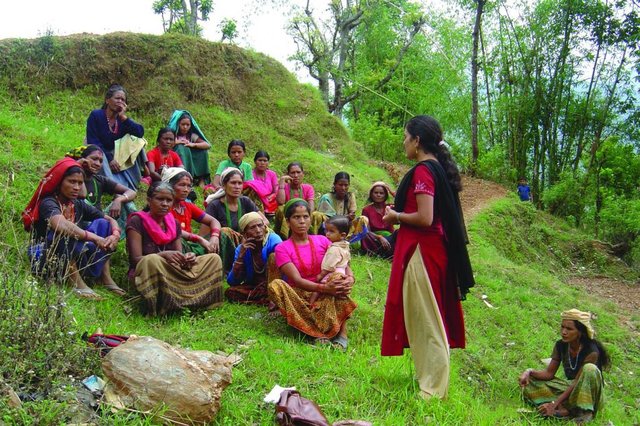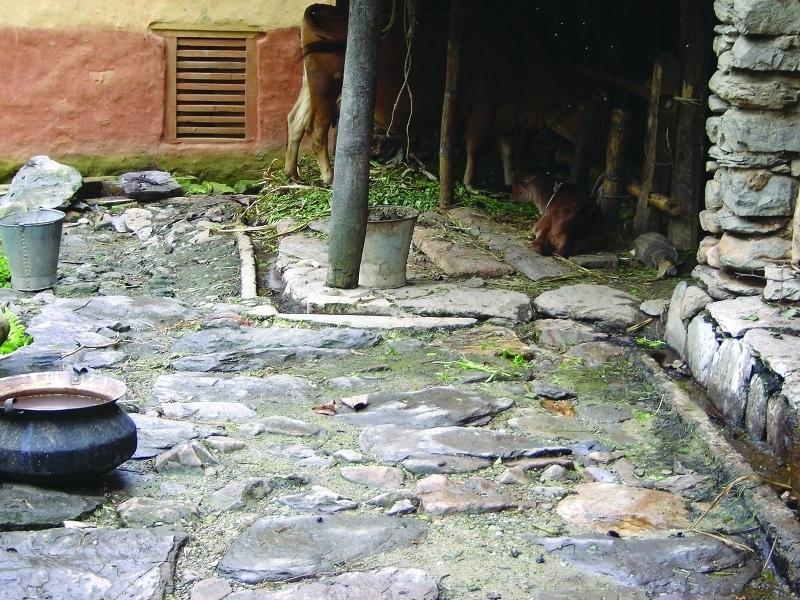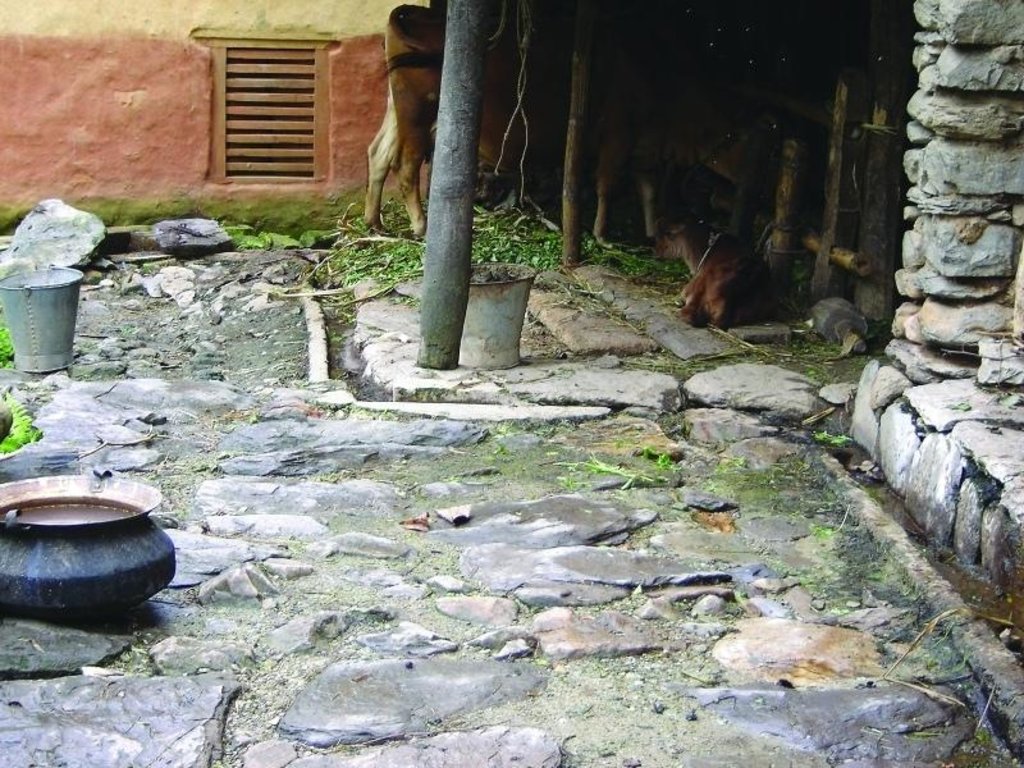Improved cattleshed for urine collection [Nepal]
- Creation:
- Update:
- Compiler: Richard Allen
- Editor: –
- Reviewers: David Streiff, Alexandra Gavilano
Mutra sankalan ka lagi sudhariyeko goth (Nepali)
technologies_1752 - Nepal
View sections
Expand all Collapse all1. General information
1.2 Contact details of resource persons and institutions involved in the assessment and documentation of the Technology
SLM specialist:
Director
Soil Management Directorate, Department of Agriculture
Nepal
SLM specialist:
Team Leader
Sustainable Soil Management Programme
Nepal
Name of project which facilitated the documentation/ evaluation of the Technology (if relevant)
Sustainable Soil Management Programme, Nepal (SSMP)Name of the institution(s) which facilitated the documentation/ evaluation of the Technology (if relevant)
HELVETAS (Swiss Intercooperation)Name of the institution(s) which facilitated the documentation/ evaluation of the Technology (if relevant)
Department of Agriculture, Soil Management Directorate, Hariharbhawan Lalitpur (doasoil) - Nepal1.3 Conditions regarding the use of data documented through WOCAT
The compiler and key resource person(s) accept the conditions regarding the use of data documented through WOCAT:
Yes
1.5 Reference to Questionnaire(s) on SLM Approaches (documented using WOCAT)

Farmer field schools on integrated plant nutrient systems [Nepal]
Participatory and collaborative learning through the farmer field school approach
- Compiler: Richard Allen

Farmer-led experimentation [Nepal]
Participatory technology testing and adaptation through farmer-led experiments
- Compiler: Richard Allen

Farmer-to-farmer diffusion [Nepal]
Wider diffusion of sustainable soil management technologies through a demand responsive farmer-to-farmer diffusion approach
- Compiler: Richard Allen
2. Description of the SLM Technology
2.1 Short description of the Technology
Definition of the Technology:
Collection of cattle urine in improved cattle sheds for use as liquid manure and organic pesticide
2.2 Detailed description of the Technology
Description:
Nitrogen is the most important macronutrient for plants, and high crop productivity can only be achieved by making sufficient nitrogen available to crops. Nitrogen is also the most limiting nutrient in farms across Nepal’s midhills. Traditionally farmers applied farmyard manure to fertilise their needs. In many places this is being supplemented or even entirely replaced by inorganic fertiliser - mainly urea. The price of inorganic fertiliser has increased continuously in recent years and it is only available in limited quantities in areas far from the roadheads. On the other hand, cultivation practices are intensifying with increased cropping intensities and more nutrient-demanding crops as, for example, local varieties are replaced by hybrids and new crops are grown. This can easily lead to declining soil fertility and nutrient mining if it is not compensated for by an equivalent increase in organic or mineral fertilisation.
Cattle urine is a viable alternative to mineral fertiliser. Of the nitrogen excreted by cattle, 60% is found in the urine and only 40% in dung. In traditional sheds, urine is left to be absorbed in the bedding material, while excess urine is channelled out of the shed and disposed of. The technology described here - improved cattle sheds- are designed for collecting the urine in a pit or drum. This pit is generally located in the shed itself or just outside connected to the drainage channel through a pipe and protected from rain and runoff. Where urine is collected for incorporation in farmyard manure, the pit may be directly connected to the manure pit or heap. Urine that is going to be used as liquid manure or organic pesticide has to be stored in a drum for fermentation.
A household with two cattle can save the equivalent of purchasing about 100 kg of urea over one year by applying urine either directly as liquid fertiliser or as a component in improved farmyard manure.
2.3 Photos of the Technology
2.5 Country/ region/ locations where the Technology has been applied and which are covered by this assessment
Country:
Nepal
Further specification of location:
Midhill districts of Nepal
Map
×3. Classification of the SLM Technology
3.1 Main purpose(s) of the Technology
- Collect fertilizer
3.2 Current land use type(s) where the Technology is applied

Cropland
- Annual cropping
Comments:
Major land use problems (compiler’s opinion): Intensifying cultivation practices with either 1) inadequate application of fertilisers leading to a decline in soil fertility and the mining of soil nutrients or 2) application of too much fertiliser causing environmental problems through excessive leaching, and losses of fertiliser in surface runoff and consequent eutrophication or nitrification of streams, ponds, or groundwater.
3.5 SLM group to which the Technology belongs
- integrated soil fertility management
3.6 SLM measures comprising the Technology

management measures
- M6: Waste management (recycling, re-use or reduce)
Comments:
Main measures: management measures
3.7 Main types of land degradation addressed by the Technology

chemical soil deterioration
- Cn: fertility decline and reduced organic matter content (not caused by erosion)
3.8 Prevention, reduction, or restoration of land degradation
Specify the goal of the Technology with regard to land degradation:
- not applicable
4. Technical specifications, implementation activities, inputs, and costs
4.1 Technical drawing of the Technology
Technical specifications (related to technical drawing):
a) Urine collection and direct incorporation in covered farmyard manure pit.
b) Urine collection for later application as liquid manure or organic pesticide.
Technical knowledge required for field staff / advisors: low
Technical knowledge required for land users: low
Main technical functions: increase in organic matter, increase in soil fertility, increase in soil productivity, pest control
Secondary technical functions: supplementary irrigation
4.2 General information regarding the calculation of inputs and costs
Specify how costs and inputs were calculated:
- per Technology unit
Specify unit:
Urine collection system
Specify currency used for cost calculations:
- USD
Indicate average wage cost of hired labour per day:
2.00
4.3 Establishment activities
| Activity | Timing (season) | |
|---|---|---|
| 1. | Provide slight slope to the cattle shed floor | |
| 2. | Dig a draining ditch and a collection pit, if possible at the lowest point inside the shed. If this is not possible, an outside pit should be dug, protected from rain and runoff, and connected with the draining ditch through a pipe or a channel. | |
| 3. | Make the floor as impermeable as possible; e.g. with cement (expensive and durable), stone slabs, soil compaction, or clay (cheap but not durable). The more impermeable the floor, the more urine can be collected. | |
| 4. | Provide a jug/’decapitated’ plastic bottle/cup/etc. to scoop the urine out of the collection pit into the fermentation drum. |
4.4 Costs and inputs needed for establishment
| Specify input | Unit | Quantity | Costs per Unit | Total costs per input | % of costs borne by land users | |
|---|---|---|---|---|---|---|
| Labour | Labour | per unit | 1.0 | 6.0 | 6.0 | 100.0 |
| Construction material | Plastic drum | per unit | 6.0 | 1.0 | 6.0 | 100.0 |
| Total costs for establishment of the Technology | 12.0 | |||||
| Total costs for establishment of the Technology in USD | 12.0 | |||||
Comments:
Duration of establishment phase: 0.25 month(s)
4.5 Maintenance/ recurrent activities
| Activity | Timing/ frequency | |
|---|---|---|
| 1. | When the collection pit is full, the collected urine has to be removed from the pit and stored in a plastic drum for fermentation. | |
| 2. | The urine is applied as liquid fertiliser by jug or through drip irrigation. |
4.6 Costs and inputs needed for maintenance/ recurrent activities (per year)
Comments:
It is clear that cattle or buffaloes are required for urine production. To help farmers to use their own resources, it is suggested to start with the cheapest and simplest form of urine collection and a compacted sloping floor and a collection pit within the shed. This allows the farmer to see the benefits of collecting the urine and will encourage them to invest in more expensive materials to improve the efficiency of urine collection. Cost as in January 2007
5. Natural and human environment
5.1 Climate
Annual rainfall
- < 250 mm
- 251-500 mm
- 501-750 mm
- 751-1,000 mm
- 1,001-1,500 mm
- 1,501-2,000 mm
- 2,001-3,000 mm
- 3,001-4,000 mm
- > 4,000 mm
Specifications/ comments on rainfall:
Annual rainfall: Also 2000-3000 mm
Agro-climatic zone
- humid
Thermal climate class: subtropics
5.2 Topography
Slopes on average:
- flat (0-2%)
- gentle (3-5%)
- moderate (6-10%)
- rolling (11-15%)
- hilly (16-30%)
- steep (31-60%)
- very steep (>60%)
Landforms:
- plateau/plains
- ridges
- mountain slopes
- hill slopes
- footslopes
- valley floors
Altitudinal zone:
- 0-100 m a.s.l.
- 101-500 m a.s.l.
- 501-1,000 m a.s.l.
- 1,001-1,500 m a.s.l.
- 1,501-2,000 m a.s.l.
- 2,001-2,500 m a.s.l.
- 2,501-3,000 m a.s.l.
- 3,001-4,000 m a.s.l.
- > 4,000 m a.s.l.
Comments and further specifications on topography:
Slopes on average: Also moderate (6-10%), rolling (11-15%) and hilly (16-30%)
Landforms: Also footslopes
Altitudinal zone: Also 1000-1500 m a.s.l. and 1500-2000 m a.s.l.
5.6 Characteristics of land users applying the Technology
Market orientation of production system:
- subsistence (self-supply)
- commercial/ market
Individuals or groups:
- individual/ household
Indicate other relevant characteristics of the land users:
Off-farm income specification: In most farm households, off-farm income plays at least a minor and increasingly a major role. Occasional opportunities for off-farm income present themselves in the form of daily labour wages. Some households’ members receive regular salaries, whilst an increasing number of Nepalis are working in India, the Middle East, Malaysia, and elsewhere and sending remittance incomes home.
5.7 Average area of land used by land users applying the Technology
- < 0.5 ha
- 0.5-1 ha
- 1-2 ha
- 2-5 ha
- 5-15 ha
- 15-50 ha
- 50-100 ha
- 100-500 ha
- 500-1,000 ha
- 1,000-10,000 ha
- > 10,000 ha
5.8 Land ownership, land use rights, and water use rights
Land ownership:
- individual, not titled
- individual, titled
Land use rights:
- leased
- individual
6. Impacts and concluding statements
6.1 On-site impacts the Technology has shown
Socio-economic impacts
Income and costs
expenses on agricultural inputs
Comments/ specify:
Reduced expenses for agrochemicals
Other socio-economic impacts
Shed management and cleaning
Organic crop production
Animal health
Establishment costs if cement is used
Socio-cultural impacts
Social prestige as seen as progressive farmer
Handling of dung and urine
Ecological impacts
Other ecological impacts
Eutrophication and nitrification of waterbodies due to controlled outflow of urine
6.2 Off-site impacts the Technology has shown
groundwater/ river pollution
Comments/ specify:
Reduction of nutrient influx into water bodies
Dependence on outside inputs
6.4 Cost-benefit analysis
How do the benefits compare with the establishment costs (from land users’ perspective)?
Short-term returns:
positive
Long-term returns:
positive
How do the benefits compare with the maintenance/ recurrent costs (from land users' perspective)?
Short-term returns:
positive
Long-term returns:
positive
Comments:
The high cost of mineral fertiliser means that the establishment costs are soon recovered. In the long-term, the major reduction in fertiliser cost leads to increased benefits.
6.5 Adoption of the Technology
Comments:
Comments on spontaneous adoption: Approximately 30% of SSMP supported farmers groups and about 15% none members of SSMP supported groups adopted the tehnology.
6.7 Strengths/ advantages/ opportunities of the Technology
| Strengths/ advantages/ opportunities in the compiler’s or other key resource person’s view |
|---|
|
The use of urine collected on-farm reduced the requirement for mineral fertiliser which reduced production costs and outside dependency How can they be sustained / enhanced? Further promotion of the technology will increase this impact |
|
Human urine can also be used to fertilise crops, but needs to be fermented longer and may be socially less accepted How can they be sustained / enhanced? Promote the use of urine further and show there is no problem with using human urine |
|
Applying urine as a liquid manure also irrigates the crops (fertigation) How can they be sustained / enhanced? The link between urine application and drip irrigation, or other forms of smallscale irrigation, should be promoted. It has been tested and applied successfully by farmers related to SSMP in Syangja and Surkhet in western Nepal |
6.8 Weaknesses/ disadvantages/ risks of the Technology and ways of overcoming them
| Weaknesses/ disadvantages/ risks in the compiler’s or other key resource person’s view | How can they be overcome? |
|---|---|
| The initial costs incurred whilst improving a durable shed using cement may hinder adoption | Simpler methods such as using clay soil, compacting the fl oor, and using stone slates may, however lead to less urine being collected |
| Project incentives (cement, plastic drum) have hindered adoption in some places |
No incentives should be provided, rather very simple methods should be demonstrated and adapted to local conditions |
| Urine collection is feasible for subsistence farm households or small scale commercial producers. It may, however, not be applicable for larger scale commercial vegetable producers as a balance between area needed for livestock and growing the crops is needed | Urine could become a tradeable commodity which would see large-scale livestock producers selling their urine to large-scale vegetable producers. |
7. References and links
7.1 Methods/ sources of information
7.2 References to available publications
Title, author, year, ISBN:
STSS; SSMP (2001) Farmyard Manure and Compost Management (in Nepali). Kathmandu: Soil Testing Services Section, Department of Agriculture and Sustainable Soil Management Programme
Available from where? Costs?
SSMP
Links and modules
Expand all Collapse allLinks

Farmer field schools on integrated plant nutrient systems [Nepal]
Participatory and collaborative learning through the farmer field school approach
- Compiler: Richard Allen

Farmer-led experimentation [Nepal]
Participatory technology testing and adaptation through farmer-led experiments
- Compiler: Richard Allen

Farmer-to-farmer diffusion [Nepal]
Wider diffusion of sustainable soil management technologies through a demand responsive farmer-to-farmer diffusion approach
- Compiler: Richard Allen
Modules
No modules





